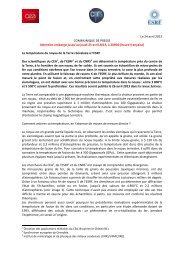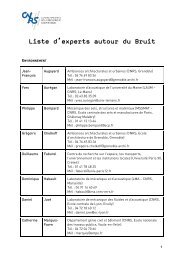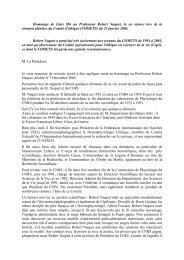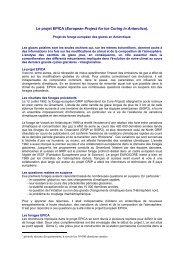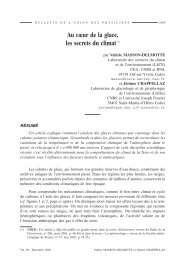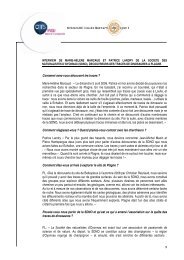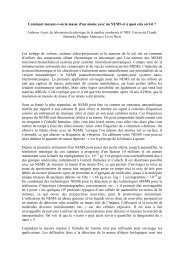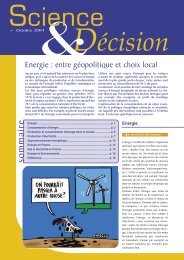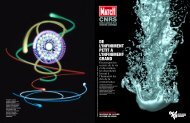Background: <strong>The</strong> Global Scientific ContextThis is a golden era <strong>for</strong> astronomy. <strong>The</strong> past few years have brought a number of epochal discoveries, from the detectionof the first planets orbiting other stars, to the accelerating Universe dominated by enigmatic dark energy. Europe isat the <strong>for</strong>efront in all areas of contemporary astronomy and the challenge now is to consolidate and strengthen this position<strong>for</strong> the future.In a world of ever-fiercer global competition, <strong>European</strong> astronomy has reached its current position by learning to cooperateon both a bi- and a multilateral basis, and especially through the <strong>European</strong> Southern Observatory (ESO) and the <strong>European</strong>Space Agency (ESA). However, the scientists and research programmes in universities and research organisations at thenational level remain the backbone of <strong>European</strong> astronomy. <strong>The</strong> scientific challenges of the future will require a comprehensivelong-term strategy and the coordination of financial and human resources, underpinned by vibrant, national scientificand technological communities across the whole of Europe. This approach is also needed if Europe is to be a strongand effective partner in the largest, global projects.<strong>ASTRONET</strong>, supported as an ERA-Net by the <strong>European</strong> Commission, was created by the major <strong>European</strong> funding agenciesand research organisations to prepare long-term scientific and investment plans <strong>for</strong> <strong>European</strong> astronomy <strong>for</strong> thenext 10–20 years. <strong>The</strong> present Infrastructure <strong>Roadmap</strong> represents the core of this ef<strong>for</strong>t and is unique in the history of<strong>European</strong> astronomy. Firstly, it considers the whole of astronomy: from gamma-ray to radio wavelengths as well as particles,from the ground and in space, and from the distant borders of the Universe to in situ exploration of Solar Systembodies, and includes theory, computing and laboratory studies. Secondly, it involves all of Europe, including the new EUmember states, and explicitly includes the human resources that are crucial to the delivery of the scientific outcome.We know that astronomy interests peopleof all ages; as well as expanding theirhorizons, it can encourage younger peopleto consider careers in science or technology.Astronomy also drives high technologyin areas such as optics and in<strong>for</strong>matics.<strong>The</strong>se are all powerful reasons to support<strong>European</strong> astronomy. As this report shows,astronomy is also a fully international sciencewhose communities welcome theestablishment of the <strong>European</strong> ResearchArea.Credit: NASA, ESA, CXC, M. Bradac (University of Cali<strong>for</strong>nia, Santa Barbara, USA), and S. Allen (Stan<strong>for</strong>d University, USA)Hubble and Chandra composite of the galaxy clusterMACS J0025.4-1222, showing the hot, diffuse gastrapped in the cluster’s powerful gravitational field.2
TOWARDS A STRATEGIC PLAN FOR EUROPEAN ASTRONOMYScience-Driven PrioritisationScientific planning must be based on scientific goals.Accordingly, this process began with the development ofa Science Vision <strong>for</strong> <strong>European</strong> Astronomy, published inOctober 2007. It reviewed and prioritised the main scientificquestions that <strong>European</strong> astronomy should address overthe next 10–20 years under four broad headings:• Do we understand the extremes of the Universe?• How do galaxies <strong>for</strong>m and evolve?• What is the origin and evolution of stars and planets?• How do we fit in?In doing so, the Science Vision identified the types ofresearch infrastructure that would be needed to answerthe key questions under each heading, but did not addressspecific projects. <strong>The</strong> present Infrastructure <strong>Roadmap</strong>builds on the Science Vision. It aims to develop a matchingset of priorities <strong>for</strong> the material and human resourcesneeded to reach these goals, and a plan <strong>for</strong> phasing thecorresponding investments so that the bulk of the ScienceVision goals can be reached within realistic budgets. Itextends the ESFRI <strong>Roadmap</strong> by analysing and comparingthe flagship projects in all areas of astronomy in technicaland financial detail, and by addressing directly the hardfacts of the implementation phase.<strong>The</strong> Working Group and Panels were mindful of existingnational and international strategic plans, including those ofESFRI, ESO and ESA. <strong>The</strong>y also considered the global context,including the plans of our major international partners.Close contact was maintained with the infrastructure networksOPTICON, RadioNet, EuroPlaNet and ILIAS and theERA-Net ASPERA. <strong>The</strong> Working Group has sole responsibility<strong>for</strong> the final report.Three aspects of the <strong>Roadmap</strong> are notable. Firstly, itemphasises the need to include the entire electromagneticspectrum — and beyond — in the study of most cosmicphenomena, from young stars and planets to supermassiveblack holes in the distant Universe. Secondly, thepriorities of proposed new space missions were reviewedindependently by the <strong>ASTRONET</strong> and ESA Cosmic Visionpanels. Although they were prepared by different groupsof scientists, the conclusions were very similar. Thirdly, the<strong>Roadmap</strong> identifies a number of gaps, <strong>for</strong> which technologicalsolutions are needed, as well as inconsistencies in currentpolicies. It points to the lack of consistency betweenthe resources devoted to major projects and their scientificexploitation, and to the need to coordinate space projectswith the matching ground-based ef<strong>for</strong>ts that are needed tosecure the full scientific returns from the investment.<strong>The</strong> <strong>ASTRONET</strong> <strong>Roadmap</strong> was developed primarily onscientific grounds by a Working Group appointed by the<strong>ASTRONET</strong> Board. Existing and proposed infrastructureprojects across astronomy — well over 100 in all —were reviewed by three specialist panels of top-ranking<strong>European</strong> scientists. Two other panels considered the concomitantneeds <strong>for</strong> theory, computing and data archiving,and human resources including education, recruitment,public outreach and industrial involvement. Overall, over60 <strong>European</strong> scientists were directly involved in this ef<strong>for</strong>t.Feedback from the community was invited through botha web-based <strong>for</strong>um and a large symposium held in June2008.<strong>The</strong> panels worked by assessing projects requiring newfunds of €10 million or more from <strong>European</strong> sources andon which spending decisions are required after 2008. <strong>The</strong>yexamined each project <strong>for</strong> its potential scientific impact, itsuniqueness, its level of <strong>European</strong> input, the size of the astronomicalcommunity that would benefit from it, and its relevanceto advancing <strong>European</strong> high-technology industry.Artist’s impression of the the extrasolar planet HD 189733b.Credit: ESA/Hubble/M. Kornmesser3



